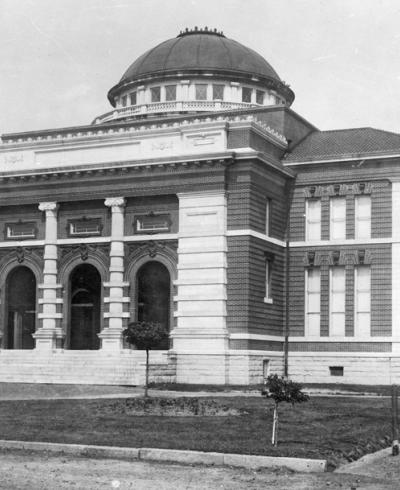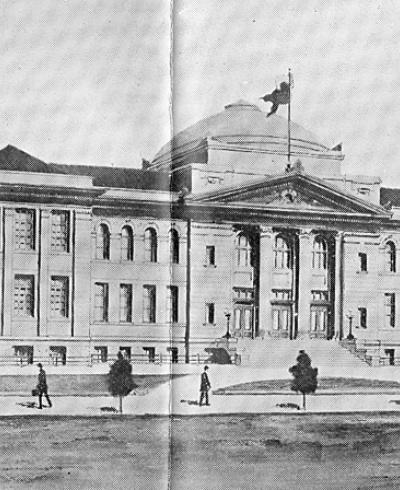From the NC Architects website:
Oliver Duke Wheeler (May 21, 1864-October 27, 1942), was an architect who with his sequence of partners and associates--Luke Hayden, Louis E. Schwend, James M. McMichael, Neil Runge, D. Anderson Dickey, and others--had a long career in North Carolina and one of the state's most prolific practices of the day. Headquartered in Charlotte from 1899 onward, Wheeler's firms were especially well known for their economical classical courthouses of similar designs, but they also planned a wide variety of other buildings. Wheeler's firms also did extensive work in South Carolina. Of their many commissions, including a large number reported in the Manufacturers' Record, only a small proportion have been identified.
Oliver Duke Wheeler was born in Freedom, New York, a son of farmers William and Eliza Wheeler, who had migrated to America from Wales. In 1886 young Wheeler moved to Atlanta to work in the construction business, and in the same year he married Alice Carter from Russell County, Virginia. He later married Nannie Crenshaw, who outlived him. Throughout his career, first in Atlanta and then in Charlotte, Wheeler exhibited a pattern of forming architectural partnerships that were highly productive but short-lived. Except for the untimely death of his young associate Louis E. Schwend, the reasons for the frequent turnover of business partners are not known. Like other architects of the era, Wheeler and his associates kept their names in front of the public in the Manufacturers' Record and other publications. From time to time, the firm would send in an impressive roster of projects for which they had "completed plans," but it is not certain how many of these were actually constructed.
Wheeler's first partnership came when he established an architectural firm in Atlanta with Luke Hayden, probably in the 1890s. The commission for Trinity Methodist Church in Charlotte brought the partners to the Queen City: The Manufacturers' Record of April 15, 1898, noted that Charlotte's Trinity M. E. congregation had adopted plans by Hayden and Wheeler of Atlanta.
Seeing the opportunities of the New South capital of the Carolinas, Hayden and Wheeler moved their main office to Charlotte in April, 1899, and took Louis E. Schwend (1875-1900) as a third partner. Like C. C. Hook and others, they moved to a business and industrial center on the verge of explosive growth. They captured a plum project: the Manufacturers' Record of July 21, 1899, reported that Hayden, Wheeler, and Schwend had drawn plans for a 6-story office building of the Charlotte Consolidated Construction Company (the "4C's"), and in December, 1899, the firm reported that they had drawn plans for a 2-story, stone and terra cotta office building for the same firm. The 4C's was a dynamic young company, which developed the new Charlotte suburb of Dilworth and many other ventures. One of its leaders was Edward Dilworth Latta, for whom Dilworth was named. (Latta also employed architect C. C. Hook to plan residences and other Dilworth buildings.) During 1899, Hayden, Wheeler, and Schwend placed many notices in the Manufacturers' Record of plans they had drawn for clients in Charlotte and various other towns. How many of these were built is unknown. Their notices appeared alongside Hook's, whose firms' geographic range often overlapped with Wheeler's.
Like other firms, Wheeler's office sometimes submitted designs that were not selected by the clients: for example, the firm submitted (and illustrated in their promotional publication) a classically detailed courthouse for Alexander County in 1899, but the county's leaders actually built a simpler courthouse planned by the B. F. Smith Fireproofing Company, a popular firm in the state.
Although Louis Schwend worked with Hayden and Wheeler only briefly, he had a lasting influence on Wheeler's firms' production. As related by Robert M. Topkins and Joe A. Mobley, in 1899 Schwend represented the firm in the winning design for the Iredell County Courthouse in Statesville. He produced a bold and classically inspired design, presented when tastes were beginning to shift from the eclectic to the classical. The Charlotte Daily Observer stated, "The design is quite a credit to young Mr. Schwend, who won it in hot competition." Although in 1900 Schwend, identified as an architect and native of Ohio, was boarding with the Wheeler family, he subsequently returned to his native Cincinnati where he died in November. For several years, Wheeler and his partners used Schwend's courthouse design in many counties across the state over the years, repeating the symmetrical but lively composition with central portico, mansard-like dome, and stepped back façade. The basic design could be more or less costly depending on local budget and preferences.
In about 1900 the firm of Hayden, Wheeler, and Schwend published a promotional booklet entitled "Modern Buildings," which indicated that they had branch offices in Greensboro, N. C., and Columbia, S. C., as well as the main office in Charlotte. Following Schwend's death in November 1900, subsequent editions of the publication reflected the rapid changes in Wheeler's firms: in about 1902 Wheeler and McMichael inserted their name, and in about 1903 Wheeler and Runge stamped the book with their firm name as "successor firm" to the original authors.
After 1900, Hayden, Wheeler, and Company had offices in Greensboro and Columbia. Wheeler also opened his own practice in Charlotte in 1901, and he moved there permanently by 1902. There Wheeler formed a brief partnership (1901-1902) with James M. McMichael, who soon went on to his own long and prolific practice. In 1903 Wheeler joined with Neil Runge to form Wheeler, Runge, and Company, and in 1905 the firm added another associate, D. Anderson Dickey, as Wheeler, Runge, and Dickey. These three opened an office in Nashville, Tennessee, by 1907. In 1908, however, Runge and Dickey formed their own firm in Nashville. The following year C. F. Galliher and Eugene John Stern joined Wheeler in yet another partnership. Galliher left in 1909, after only ten months, to join Runge and Dickey in Nashville. Eugene J. Stern, originally from Austria-Hungary, had studied architecture in New York. At long last, Wheeler had a lasting partnership, and Wheeler and Stern operated successfully in Charlotte until the onset of World War I. Although Wheeler lived until 1942, and was listed as an architect living in Charlotte in 1930, little is known of his work after his partnership with Stern ended.
Throughout Wheeler's many partnerships, the firms' work encompassed a wide range of building types, styles, and locations. They geared popular styles to suit the budgets and tastes of the clients in small towns and cities. Their numerous public and commercial projects included not only courthouses, but also churches, schools, orphanages, county jails, theaters, and commercial buildings. Their residential work included a few houses in late Queen Anne style, but Wheeler's firms generally favored the popular "Southern Colonial" style, as exemplified by the James H. Lee House (1912-1914), built for a leading businessman in Monroe. As in their courthouses, Wheeler and his partners developed a standard and widely accepted basic design--their Colonial Revival houses could vary in size and elaboration but normally featured a broad central passage, a colossal portico, and a veranda extending into a porte cochere.
Certainly the Wheeler firms' best-known works in North Carolina are their nine county courthouses built from 1899 to 1913. They were based on Schwend's Beaux-Arts design of the Iredell County Courthouse, which appealed to county commissioners seeking facilities of modern, convenient, classical design and reasonable cost in a period of rapid courthouse construction. Such edifices were erected in Ashe, Avery, Caldwell, Randolph, Scotland, Stokes, Watauga, and Wilkes Counties. The courthouses in Caldwell, Scotland and Watauga were razed in the 1960s, but the other six still stand. The clients for the Wilkes County Courthouse (1902) wrote, "We think this courthouse is point of size, convenience and price decidedly best suited to our ability and wants. . . . we are reliably informed [that it is] the best and most convenient cheap courthouse in the state."
Wheeler took an active role in promoting and organizing the architectural profession in North Carolina. The Wilmington Star reported on December 29, 1900, that "O.D. Wheeler was elected to the executive committee of the newly organized Southeastern Architectural League, at Charlotte." He was also active in the successor North Carolina Architectural Association, which was organized in 1906 at Wrightsville Beach. When the North Carolina chapter of the American Institute of Architects was formed in 1913, Wheeler and other architects (including prominent Charlotteans) declined to join the AIA (in part because of regional differences, in part because of restrictions on fee structure), and continued their NCAA activities. In 1940 the NCAA and the NCAIA merged.
At Wheeler's death, the Charlotte Observer (October 29, 1942) recalled that he had been one of the city's most prominent architects. He had come to Charlotte, the paper reported, "to direct the building of the old Trinity Methodist Church" at South Tryon and Second Streets, and had overseen construction of "numerous churches, hospitals, and public buildings throughout Georgia and the Carolinas."
The following is a chronology of Wheeler's partnerships, all of which were headquartered mainly in Charlotte except Hayden and Wheeler, which was formed in Atlanta: Hayden and Wheeler (before 1899); Hayden, Wheeler, and Schwend (1899-1900); Hayden, Wheeler, and Company (1901); Wheeler, McMichael, and Company (1901-1902); Wheeler, Runge, and Company (1903-1905); Wheeler, Runge, and Dickey (1905-1908); Wheeler, Galliher, and Stern (1908-1909); Wheeler and Stern (1909-late 1910s).
The building lists for Wheeler and his firms cover chiefly the early years of Wheeler's career, as cited in the Manufacturer's Record up to 1910 (from notes by Michelle Michael, as listed in "The Rise of the Regional Architect"). Many of these indicate only that the firm had drawn plans, without any indication of whether those plans were selected, a contract let, or the building actually constructed. These included numerous buildings in Charlotte, Fayetteville, High Point, Monroe, Statesville, and elsewhere. The building list is selective, encompassing the firms' best known buildings and a representative sampling of others for which there is information about construction, location, and status. More research, drawing especially on the Manufacturers' Record from 1910 onward, will doubtless uncover and confirm additional attributions.



Add new comment
Log in or register to post comments.